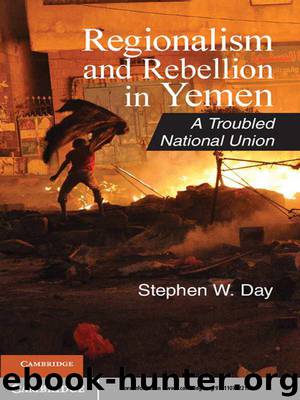Regionalism and Rebellion in Yemen (Cambridge Middle East Studies) by Day Stephen W

Author:Day, Stephen W. [Day, Stephen W.]
Language: eng
Format: epub
ISBN: 9781139419000
Publisher: Cambridge University Press
Published: 2012-05-16T05:00:00+00:00
These were the worst disturbances in the south since the 1994 war. They signified a widespread feeling of anger and frustration throughout the southern provinces.16 Immediately after the second shooting incident, President Salih sent the southern interior minister Husayn Arab, along with the attorney general and a deputy director of political security (both from the highland region), to investigate the violence in al-Mukalla. When this government delegation from Sanaa met with the province’s executive board, a few native Hadrami board members were brave enough to register a formal letter of complaint against the government in Sanaa.17 This letter claimed that the disturbances resulted from popular frustration at the continued northern military presence, and the generally lawless conditions in the province. Over the next few weeks, President Salih tried to ease the crisis by meeting with these and other prominent Hadramis in Sanaa.18 After holding several meetings, Salih decided the best solution was to create special local councils in Hadramaut on a short-term basis.
Just as he had done after the 1994 war, President Salih used the subject of local government to serve his own political purposes. But in this case, his offer was rejected as insufficient. Shortly after Yemen’s civil war in 1994, a group of civic and business leaders in al-Mukalla had proposed that President Salih establish an independent local government in Hadramaut. At the time, they were told this would not be possible because people in other provinces would want the same thing.19 What was instructive about Salih’s motives, after the shootings in al-Mukalla in June 1996, is that he did not invite the same civic and business leaders to join consultations in Sanaa. Salih first extended an invitation to the leading members of his GPC party in Hadramaut, including Hasan Salih Ba Awm, who directed Hadramaut’s education office and was one of the board members who registered the original letter of complaint.
During consultations with the president in Sanaa, Hasan Salih Ba Awm spoke directly about the need to remove northern military and security forces, in order to establish a normal sense of law and order in the province.20 But Salih was not satisfied with this advice. Shortly afterward, Ba Awm resigned his post in the GPC. Later the president brought a second delegation of “traditional” Hadrami leaders to Sanaa, including many of the province’s top tribal shaykhs.21 It was during the president’s meeting with these Hadrami shaykhs that he offered to create special local councils in the province. This was significant because it revealed President Salih’s preference for dealing with the tribes, which he hoped to manipulate through the same divide and rule tactics he used in the north. During the second meeting in Sanaa on June 19, 1996, the president proposed nominating individuals from Hadramaut’s “traditional” leadership to serve on a local council, which would then advise the northern governor, Salih al-Khawlani, and his staff. Some members of the tribal delegation supported the president’s offer, but a majority eventually turned against the idea.22
The Hadrami community of Yemen
Download
This site does not store any files on its server. We only index and link to content provided by other sites. Please contact the content providers to delete copyright contents if any and email us, we'll remove relevant links or contents immediately.
| Arms Control | Diplomacy |
| Security | Trades & Tariffs |
| Treaties | African |
| Asian | Australian & Oceanian |
| Canadian | Caribbean & Latin American |
| European | Middle Eastern |
| Russian & Former Soviet Union |
The Secret History by Donna Tartt(18157)
The Social Justice Warrior Handbook by Lisa De Pasquale(11951)
Thirteen Reasons Why by Jay Asher(8451)
This Is How You Lose Her by Junot Diaz(6433)
Weapons of Math Destruction by Cathy O'Neil(5828)
Zero to One by Peter Thiel(5488)
Beartown by Fredrik Backman(5350)
The Myth of the Strong Leader by Archie Brown(5237)
The Fire Next Time by James Baldwin(5016)
How Democracies Die by Steven Levitsky & Daniel Ziblatt(4951)
Promise Me, Dad by Joe Biden(4908)
Stone's Rules by Roger Stone(4853)
100 Deadly Skills by Clint Emerson(4688)
A Higher Loyalty: Truth, Lies, and Leadership by James Comey(4550)
Rise and Kill First by Ronen Bergman(4543)
Secrecy World by Jake Bernstein(4388)
The David Icke Guide to the Global Conspiracy (and how to end it) by David Icke(4377)
The Farm by Tom Rob Smith(4321)
The Doomsday Machine by Daniel Ellsberg(4243)
